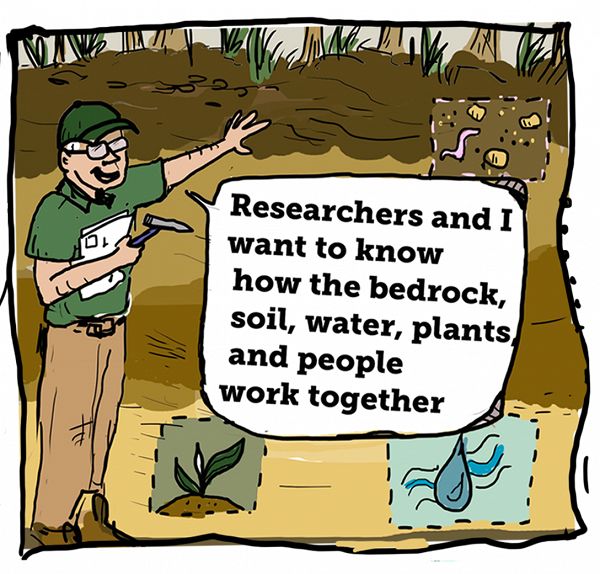Jul 14, 2016
An illlustrated introduction to the Calhoun Critical Zone Observatory!
By Justin Richardson and Dan Richter.
Illustrated by Alana McGillis
Panel 1. A stream flows through a forested landscape as seen at the Calhoun Critical Zone Observatory (CCZO) in South Carolina.
Panel 2. Dr. Dan Richter waves and says, “Hi, I am Dr. Dan Richter and I lead the research conducted at the Calhoun CZO!”
Panel 3. Dr. Richter shows a soil profile and explains that CCZO researchers want to know how the bedrock, soil, water, plants, and people work together.
Panel 4. The Calhoun Experimental Forest was once a cotton plantation where life was difficult for most farmers but even tougher for slaves. People pick cotton in a cotton field.
Panel 5. An eroded hillside shows that farming was also hard on the land causing massive erosion.
Panel 6. A forest scientist plants tree seedlings across a landscape in effort to learn how forests and soil regenerate after farming.
Panel 7. Since planting the trees, researchers have been watching the regeneration of the forest and soil. Dr. Richter cores a tree for data collection.
Panel 8. Scientists from the 1950s, 1970s and today stand in the same soil pit. Soils and trees have been sampled continuously at the Calhoun Experimental Forest for 70 years.
Panel 9. A flux tower and soil probes in the CCZO study the atmosphere and deeper weathered rock and ground water below.
Panel 10. Dr. Richter explains the goal is to understand our impact on the CZ so Earth can support a healthy and productive environment.
Files
What is the Calhoun Critical Zone Observatory?
(2 MB pdf)
Printable 2-page version of this comic.

Justin B. Richardson
CZO INVESTIGATOR, STAFF. National Office outreach officer, Former CZO Post-Doctoral Fellow. Specialty: Soil biogeochemistry of plant-essential and toxic metals.
Outreach / Education Research EDUCATION/OUTREACH General Public K-12 Education
COMMENT ON "Adventures in the Critical Zone"
All comments are moderated. If you want to comment without logging in, select either the "Start/Join the discussion" box or a "Reply" link, then "Name", and finally, "I'd rather post as a guest" checkbox.
ABOUT THIS BLOG
Justin Richardson and his guests answer questions about the Critical Zone, synthesize CZ research, and meet folks working at the CZ observatories
General Disclaimer: Any opinions, findings, conclusions or recommendations presented in the above blog post are only those of the blog author and do not necessarily reflect the views of the U.S. CZO National Program or the National Science Foundation. For official information about NSF, visit www.nsf.gov.
Explore Further












